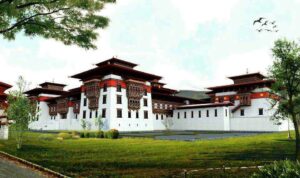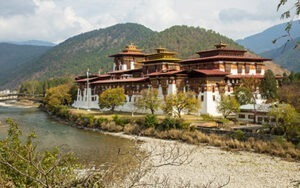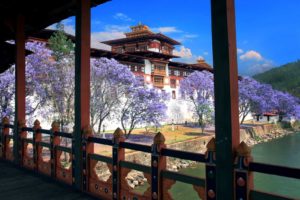Language Diversity in the Land of the Thunder Dragon: The Fascinating Origins and Features of Bhutanese Linguistics
Bhutanese linguistics
Bhutan, known as the Land of the Thunder Dragon, is a small Himalayan kingdom nestled between India and China. It is a country rich in cultural heritage, and one aspect that stands out is its diverse linguistic landscape. Bhutanese linguistics is a fascinating field that explores the origins, characteristics, and preservation of the unique languages spoken in this enchanting nation.
The origins and history of the Bhutanese language
The Bhutanese language, also known as Dzongkha, is the official language of Bhutan. Dzongkha belongs to the Tibeto-Burman language family and is closely related to Tibetan. It has its roots in the ancient Tibetan script and has evolved over centuries to become the distinct language it is today.
The origins of the Bhutanese language can be traced back to the 7th century when Tibetan influence started to spread in the region. Over time, the language developed its own distinct features, influenced by the unique cultural and historical context of Bhutan. Today, Dzongkha serves as a unifying force among the various ethnic groups in Bhutan.
The unique linguistic characteristics of Bhutanese
Bhutanese linguistics is characterized by several unique features that set it apart from other languages. One notable aspect is the tonal nature of the language. Dzongkha has six tones, which play a crucial role in distinguishing between different words and conveying meaning. This tonal system adds a musical quality to the language and is a fascinating aspect for linguists to study.
Another distinctive feature of Bhutanese linguistics is its complex verb structure. Verbs in Dzongkha can undergo various changes to indicate tense, aspect, and mood. This intricate system allows for precise expression and adds depth to the language.
Additionally, Bhutanese linguistics is marked by its rich vocabulary, particularly when it comes to nature and spiritual concepts. The language has evolved to capture the unique landscape and cultural beliefs of Bhutan, making it a truly fascinating subject of study.
The Bhutanese script and its significance
The Bhutanese script, known as Chhokey, is derived from the ancient Tibetan script. It is a highly intricate writing system that has been used for centuries to transcribe the Bhutanese language. The script is written from left to right, and each character represents a syllable.
The Bhutanese script holds great significance in the cultural and religious life of Bhutan. It is not only used for writing the Dzongkha language but also for preserving ancient texts and religious scriptures. The script is considered sacred and is an integral part of Bhutan’s cultural identity.
Language policy in Bhutan
Bhutan has a unique language policy that aims to preserve its linguistic diversity while promoting national unity. The policy recognizes Dzongkha as the official language and ensures its use in government, education, and public domains. However, it also respects the linguistic rights of various ethnic groups and encourages the preservation of their native languages.
The language policy in Bhutan is guided by the principles of multilingualism and cultural diversity. It acknowledges the importance of preserving and promoting indigenous languages as a means to safeguard cultural heritage and strengthen national identity.
Language diversity in Bhutan: Ethnolinguistic groups and dialects
Bhutan is home to a rich tapestry of ethnolinguistic groups, each with its own unique language and culture. The three main ethnic groups in Bhutan are the Ngalops, Sharchops, and Lhotshampas, each speaking their own distinct language.
In addition to the major languages, there are several dialects spoken across Bhutan. These dialects vary in pronunciation, vocabulary, and grammar, reflecting the geographical and cultural diversity of the country. The dialects serve as a testament to the linguistic richness of Bhutan and contribute to its vibrant cultural mosaic.
Multilingualism in Bhutan: The importance of preserving language
Multilingualism is a way of life in Bhutan. Many Bhutanese people grow up speaking multiple languages, including their native tongue, Dzongkha, and English, which is taught in schools. This multilingual environment fosters cultural exchange and understanding among different communities.
Preserving language is of utmost importance in Bhutan. It is not just about safeguarding linguistic diversity but also about maintaining cultural heritage and identity. Efforts are being made to document and revitalize endangered languages, ensuring that future generations can connect with their linguistic roots and preserve the unique cultural tapestry of Bhutan.
Language and cultural identity in Bhutan
Language plays a vital role in shaping cultural identity in Bhutan. It is through language that traditions, beliefs, and stories are passed down from one generation to another. Language connects people to their roots and provides a sense of belonging.
In Bhutan, cultural identity is closely tied to language. The various languages spoken in the country are a reflection of its diverse cultural heritage. By embracing and celebrating linguistic diversity, Bhutan strengthens its cultural fabric and promotes a sense of unity among its people.
Linguistic influences on Bhutanese languages
Bhutanese languages have been influenced by various linguistic traditions throughout history. The proximity to Tibet has had a significant impact on the development of the Bhutanese language, with Tibetan serving as a major source of influence.
Additionally, Bhutan’s location between India and China has exposed its languages to Indic and Sinitic linguistic elements. These influences have contributed to the unique blend of linguistic features found in Bhutanese languages, making them rich and distinct.
Efforts to preserve and promote Bhutanese languages
Recognizing the importance of linguistic diversity, Bhutan has implemented various initiatives to preserve and promote Bhutanese languages. The government has established language institutes and research centers dedicated to the study and documentation of indigenous languages.
Furthermore, Bhutanese schools incorporate local languages and cultural studies into their curriculum, ensuring that younger generations have access to their linguistic heritage. Efforts are also being made to create language learning materials and resources to facilitate the preservation and revitalization of endangered languages.
Celebrating language diversity in Bhutan
Bhutan is a treasure trove of linguistic diversity, with its unique languages and dialects contributing to its cultural richness. The origins, characteristics, and preservation of Bhutanese linguistics provide a fascinating insight into the country’s heritage.
As we celebrate language diversity in Bhutan, we recognize the importance of preserving indigenous languages and promoting multilingualism. By embracing linguistic diversity, Bhutan preserves its cultural heritage and strengthens its national identity. Let us continue to cherish and protect the linguistic tapestry of the Land of the Thunder Dragon.





























